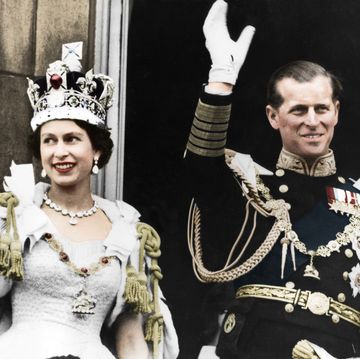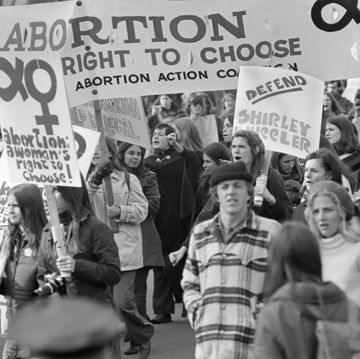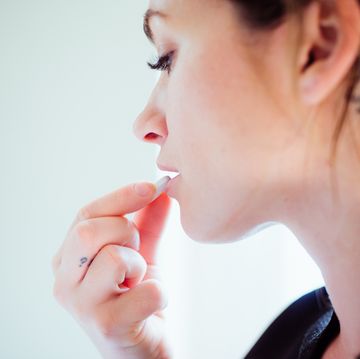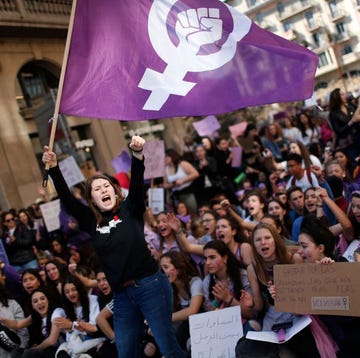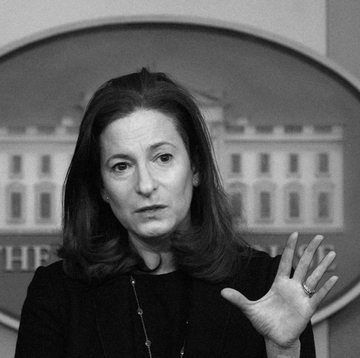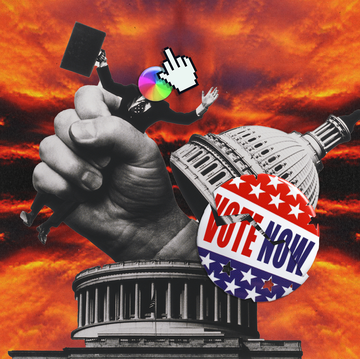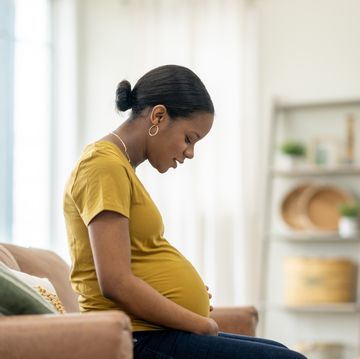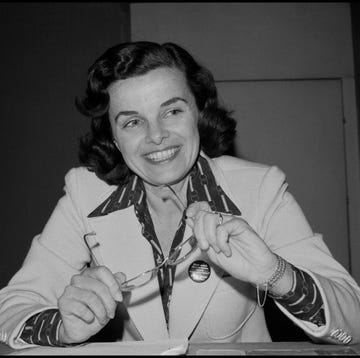When Emily Letts got pregnant, she knew she would get an abortion. Then she decided to film it. Letts, 25, is an abortion counselor at Cherry Hill Women's Center in New Jersey, which is where she had her abortion. The non-graphic video focuses on her face and shows her breathing and humming through the procedure. The doctor on the other side of the sheet is out of view. When she entered the Abortion Care Network's Stigma Busting video competition and won, the video went viral. Here, she explains why she decided to share her experience so publicly.
Becoming an abortion counselor was kind of unexpected. I was a professional actress for many years. I loved acting, but I felt fairly depressed most of the time. I disliked my body. I felt competitive toward women. I felt completely alienated from myself and everyone else because I was intent on being successful.
I had a friend who was a birth doula, and she fascinated me with her stories about giving birth and growing life. It led me to start looking at my body in a whole different way. I became what's called a "birth junkie." I trained as a doula and watched every documentary I could get my hands on. During my training, I learned there are three kinds of doulas: birth doulas, adoption doulas, and abortion doulas. A light went off in my head.
I had never been political about abortion rights before, but the idea of helping women through an abortion and supporting them and reassuring them that they are still wonderful and beautiful resonated deeply with me. I had spent so long in the trappings of competition with other women and putting too much pressure on myself that I just wanted to help women. I reached out to Cherry Hill right after I finished my training. I asked to volunteer, but instead they asked me to come in for a job interview. I was hired on the spot to be one of the clinic's abortion counselors. I fell into this perfect world that fulfills me in so many different ways.
I found out I was pregnant in November. I had been working at the clinic for about a year. It was my first pregnancy, and, full disclosure, I hadn't been using any kind of birth control, which is crazy, I know. I'm a sex educator, and I love talking about birth control. Before this experience, hormonal birth control scared me because of complications I'd heard about from friends — gaining weight, depression, etc. So I tracked my ovulation cycle, and I didn't have any long-term partners. I thought I was OK. But, you know, things happen. I wound up pregnant.
Working at an abortion clinic, you always think you're pregnant. After hearing day in and day out stories from women not knowing they're pregnant until 20 weeks or still getting their periods while pregnant, I take pregnancy tests all the time.
On a whim, I took a test, and it came up two pink lines. The moment when a woman looks down and sees those two pink lines and she's not expecting to see them, it's like time implodes and explodes simultaneously. You're caught in this tornado that just sucks out all the breath in your lungs.
Once I caught my breath, I knew immediately I was going to have an abortion. I knew I wasn't ready to take care of a child. The guy wasn't involved in my decision. I called my supervisor and said, "Excuse me, I am going to need to schedule one abortion, please." It was very early in the pregnancy, only two to three weeks.
Patients at the clinic always ask me if I can relate to them — have I had an abortion? Do I have kids? I was so used to saying, "I've never had an abortion but…" While I was pregnant and waiting for my procedure, I thought, "Wait a minute, I have to use this."
At first I was just going to write a blog. Then my administrator introduced me to a woman on YouTube who goes by Angie AntiTheist. She filmed herself having a medical abortion — after taking the pill RU486 — to show everyone that she was fine, that it's not scary, it doesn't hurt, and that she was confident in her decision to do it.
There was, of course, a huge backlash. She got death threats and all this other stuff. But what inspired me so much about her is she kept following up. After every threat or ignorant comment, she would answer with a new video on her YouTube channel directly addressing the latest criticism. She didn't hide from it. I loved that.
I searched the Internet, and I couldn't find a video of an actual surgical procedure in the clinic that focused on the woman's experience. We talk about abortion so much and yet no one really knows what it actually looks like. A first trimester abortion takes three to five minutes. It is safer than giving birth. There is no cutting, and risk of infertility is less than 1 percent. Yet women come into the clinic all the time terrified that they are going to be cut open, convinced that they won't be able to have kids after the abortion. The misinformation is amazing, but think about it: They are still willing to sacrifice these things because they know that they can't carry the child at this moment.
There are three options for a first-trimester abortion: medical abortion, which is the pill; a surgical abortion with IV sedation, where you're asleep through the whole thing; and a surgical abortion with local anesthesia during which you're awake. Women are most terrified of being awake.
I could have taken the pill, but I wanted to do the one that women were most afraid of. I wanted to show it wasn't scary — and that there is such a thing as a positive abortion story. It's my story.
Everyone at the clinic was really supportive of filming it. At first they wanted to sit down and talk about the real consequences of this. There are a lot of politics involved. We knew we could have hundreds of protesters at our door; we could have bomb threats. Working at an abortion clinic, every once in awhile it feels like you're working in a war zone.
But I said, "Bring it," and they were on board.
I knew the cameras were in the room during the procedure, but I forgot about them almost immediately. I was focused on staying positive and feeling the love from everyone in the room. I am so lucky that I knew everyone involved, and I was so supported. I remember breathing and humming through it like I was giving birth. I know that sounds weird, but to me, this was as birth-like as it could be. It will always be a special memory for me. I still have my sonogram, and if my apartment were to catch fire, it would be the first thing I'd grab.
The first night I posted the video to my Facebook page, I couldn't sleep. I went out with friends, and I was so paranoid people were looking at me a certain way because they saw my video. The intimacy of it made me nervous, even though I really wanted people to see it.
Then I looked at my Facebook wall. I was expecting this tsunami of hateful, scary things, but everyone was so breathtakingly supportive. People who I have never talked to started writing their own abortion stories.
I had one woman who messaged me saying she'd had an abortion that week and she was plagued with guilt. Her boyfriend called her a killer, but she said she was recovering well and appreciated the video. Another woman told me she'd had a miscarriage and that because of my video she felt like she could talk to me about it. Just all of these things started pouring out of women.
There were hateful responses, of course, which was the hardest part of this whole thing. When I put it up on YouTube, pro-lifers put it on their newscasts. And so I got, "You're a Nazi," "You deserve to die," "You killed your baby." Just so much blind hatred without knowing who I am or what I'm about.
Still, every time I watch the video, I love it. I love how positive it is. I think that there are just no positive abortion stories on video for everyone to see. But mine is.
I know there are women who feel great remorse. I have seen the tears. Grieving is an important part of a woman's process, but what I really wanted to address in my video is guilt.
Our society breeds this guilt. We inhale it from all directions. Even women who come to the clinic completely solid in their decision to have an abortion say they feel guilty for not feeling guilty. Even though they know 110 percent that this is the best decision for them, they pressure themselves to feel bad about it.
I didn't feel bad. I do feel a little irresponsible and embarrassed about not using birth control. I mean, Emily, wake up! What are you doing? I was going against the advice I give to patients all the time. So I had them put an IUD in after the abortion. I was able to learn and move forward. And I am grateful that I can share my story and inspire other women to stop the guilt.
RELATED:
We Aren't Afraid of Life, Sarah Palin
These Women Want to Change the Way You Think About Abortion
What You Need to Know About the Abortion Pill
To Get an Abortion in Brazil, I Lied and Said I Was Raped
Why Aren't Politicians Fighting for Your Right to an Abortion?
Follow Heather on Twitter.
Photo credit: Courtesy of Emily Letts

